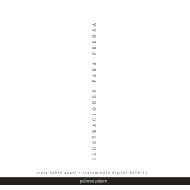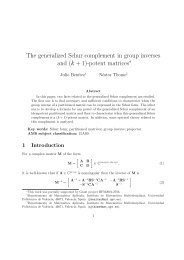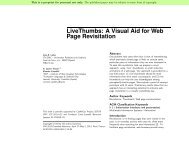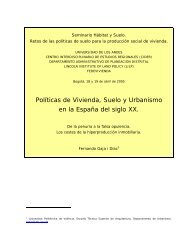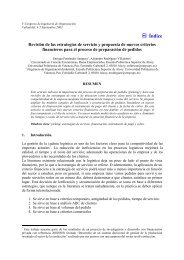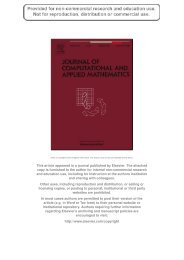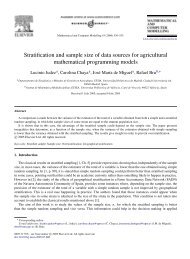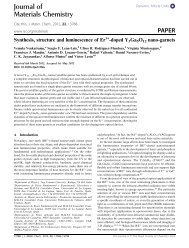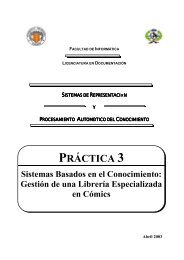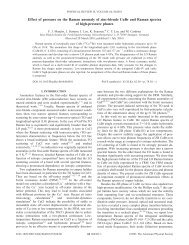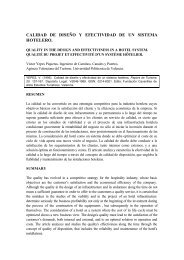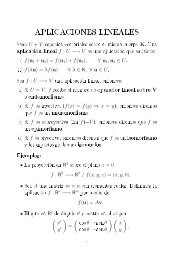Introduction to the resistivity surveying method. The resistivity of ...
Introduction to the resistivity surveying method. The resistivity of ...
Introduction to the resistivity surveying method. The resistivity of ...
Create successful ePaper yourself
Turn your PDF publications into a flip-book with our unique Google optimized e-Paper software.
48<br />
3.6.2 Septic tank survey - Texas<br />
This field survey was carried out using an 8 by 7 grid <strong>of</strong> electrodes over a buried<br />
septic tank. A Sting/Swift multi-electrode <strong>resistivity</strong> meter system (Lagmansson pers. comm.)<br />
was used for this survey. <strong>The</strong> distance between adjacent electrodes in <strong>the</strong> grid was 1 metre.<br />
All <strong>the</strong> possible measurements with <strong>the</strong> pole-pole array were made which gave a <strong>to</strong>tal <strong>of</strong> 1470<br />
datum points. For <strong>the</strong> inversion <strong>of</strong> this data set, <strong>the</strong> model blocks in <strong>the</strong> <strong>to</strong>p 2 layers are<br />
subdivided in<strong>to</strong> smaller blocks. <strong>The</strong> results are shown in <strong>the</strong> form <strong>of</strong> horizontal slices through<br />
<strong>the</strong> subsurface (Figure 36). <strong>The</strong> septic tank appears as a large high <strong>resistivity</strong> area in <strong>the</strong><br />
bot<strong>to</strong>m left quadrant <strong>of</strong> survey area in Layers 2, 3 and 4. <strong>The</strong> <strong>to</strong>pmost layer (Layer 1a in<br />
Figure 36) has a few areas with relatively large <strong>resistivity</strong> variations over short distances. In<br />
comparison, Layer 2b that extends from a depth <strong>of</strong> 1.1 <strong>to</strong> 1.5 metres shows more gradual<br />
lateral variations in <strong>the</strong> model <strong>resistivity</strong> values. In general, <strong>the</strong> deeper <strong>the</strong> layer, <strong>the</strong> smoo<strong>the</strong>r<br />
<strong>the</strong> lateral variations in <strong>the</strong> model <strong>resistivity</strong> values. This is probably partly caused by <strong>the</strong><br />
decrease <strong>of</strong> <strong>the</strong> resolution <strong>of</strong> <strong>the</strong> <strong>resistivity</strong> <strong>surveying</strong> <strong>method</strong> with depth.<br />
3.6.3 Sludge deposit - Sweden<br />
This survey covers a relatively large 21 by 17 grid by using a 3-D roll-along <strong>method</strong><br />
(Dahlin and Berns<strong>to</strong>ne 1997). To reduce <strong>the</strong> survey time, a number <strong>of</strong> parallel multi-electrode<br />
cables were used. This survey was carried out at Lernacken in Sou<strong>the</strong>rn Sweden over a closed<br />
sludge deposit. Seven parallel multi-electrode cables were used <strong>to</strong> cover a 21 by 17 grid with<br />
a 5 metres spacing between adjacent electrodes. <strong>The</strong>re were a <strong>to</strong>tal number <strong>of</strong> 3840 data<br />
points in this data set.<br />
In this survey, <strong>the</strong> cables were initially laid out in <strong>the</strong> x-direction, and measurements<br />
were made in <strong>the</strong> x-direction. After each set <strong>of</strong> measurements, <strong>the</strong> cables were shifted step by<br />
step in <strong>the</strong> y-direction until <strong>the</strong> end <strong>of</strong> <strong>the</strong> grid. In surveys with large grids, such as in this<br />
example, it is common <strong>to</strong> limit <strong>the</strong> maximum spacing for <strong>the</strong> measurements. <strong>The</strong> maximum<br />
spacing is chosen so that <strong>the</strong> survey will map structures <strong>to</strong> <strong>the</strong> maximum depth <strong>of</strong> interest<br />
(section 2.5). In this case, <strong>the</strong> maximum spacing was 40 metres compared <strong>to</strong> <strong>the</strong> <strong>to</strong>tal length<br />
<strong>of</strong> 100 metres along a line in <strong>the</strong> x-direction.<br />
<strong>The</strong> model obtained from <strong>the</strong> inversion <strong>of</strong> this data set is shown in Figure 37. <strong>The</strong><br />
former sludge ponds containing highly contaminated ground water show up as low <strong>resistivity</strong><br />
zones in <strong>the</strong> <strong>to</strong>p two layers (Dahlin and Berns<strong>to</strong>ne 1997). This was confirmed by chemical<br />
analysis <strong>of</strong> samples. <strong>The</strong> low <strong>resistivity</strong> areas in <strong>the</strong> bot<strong>to</strong>m two layers are due <strong>to</strong> saline water<br />
from a nearby sea. On a 200 Mhz Pentium Pro computer, it <strong>to</strong>ok slightly over 4 hours <strong>to</strong><br />
invert this data set. On newer computers with operating frequencies <strong>of</strong> 550 Mhz or higher, <strong>the</strong><br />
inversion time should be significantly shorter.<br />
O<strong>the</strong>r field applications include archaeological surveys and gold prospecting. A<br />
characteristic feature <strong>of</strong> 3-D surveys is <strong>the</strong> large number <strong>of</strong> electrodes and measurements. To<br />
carry out such surveys effectively, <strong>the</strong> multi-electrode system should have at least 64 (and<br />
preferably 100 or more) electrodes. This is an area where a multi-channel <strong>resistivity</strong> meter<br />
system would be useful. For fast computer inversion, <strong>the</strong> minimum requirement is a Pentium<br />
II system with at least 64 megabytes RAM and a 2 gigabyte hard-disk.<br />
Copyright (1999-2001) M.H.Loke



